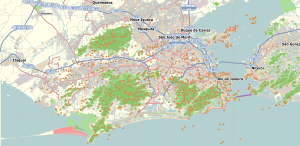Grajaú, Rio de Janeiro
Grajaú | |
|---|---|
Neighborhood | |
| Coordinates: 22°55′42″S 43°15′37″W / 22.92833°S 43.26028°W | |
| Country | |
| State | Rio de Janeiro (RJ) |
| Municipality/City | Rio de Janeiro |
| Zone | North Zone |
| Area | |
| • Total | 573.91 km2 (221.59 sq mi) |
| Population | |
| • Total | 38,671 |
Grajaú is a neighborhood in the North Zone of Rio de Janeiro, Brazil.
The neighborhood has tree-lined and quiet streets, made up of noble residences, some of which were built in the early twentieth century and preserve some of their original features, although sharing the landscape with some buildings from more recent decades.
Although it is essentially residential, Grajaú has some commercial establishments to serve the local market, and has several schools, among which stands out a traditional Catholic educational institution, the Colégio da Companhia de Maria.
The main avenue of Grajaú is Engenheiro Richard Avenue, a tribute to the founder of the neighborhood, Antônio Eugênio Richard Júnior, a banker, industrialist and one of the most influential men of the first decades of the 20th century. This avenue is divided in the middle by a flowerbed of tamarind trees, where the current headquarters of the Grajaú Tennis Club is located.
The neighborhood is intersected by important roads such as Rua Barão de Mesquita, Avenida Menezes Cortes (also known as Grajaú-Jacarepaguá highway) and Rua Barão do Bom Retiro, connecting Grajaú to the Méier region.
The center of Grajaú is located in Largo do Verdun, where the main commercial establishments are located, and in Praça Edmundo Rego, where the Byzantine-Styled Nossa Senhora do Perpétuo Socorro Church is located.


